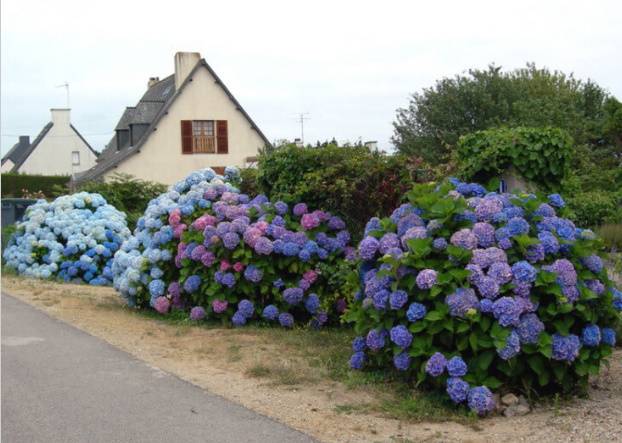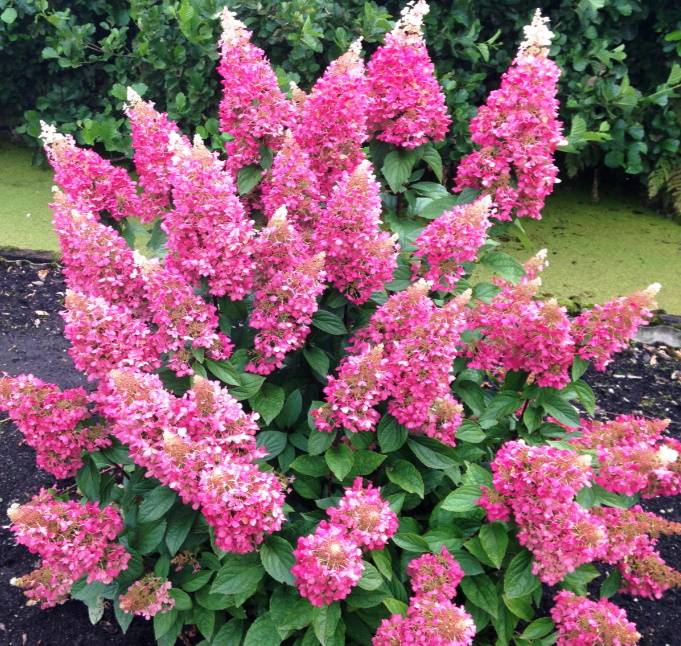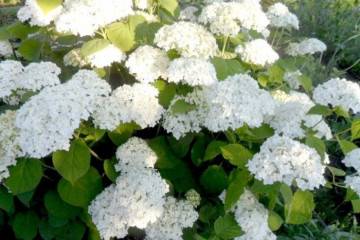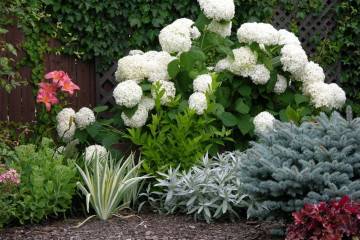What to plant next to the hydrangea and in front of it "at the feet"
Content:
- Popular varieties of hydrangea
- What plants is hydrangea combined with
- What to plant next to a tree hydrangea
- What can be planted next to panicle hydrangea in the garden
- Neighborhood of thuja and hydrangeas
- What to plant under hydrangea
- What to plant next to a hydrangea in a flower bed
- Is it possible to plant hydrangeas of different colors next to each other
Growing a hydrangea near your home is a very pleasant experience, because caring for a plant is quite simple, and you can admire the bushes for a long time. In favorable conditions, the garden hydrangea grows up to 2-3 m. The territory on which it grows, with the beginning of luxurious flowering, turns into a fabulous flower bed. Especially if there are other plants nearby, which are not inferior in their decorativeness to luxurious bushes.
Popular varieties of hydrangea
In Japan, from where the hydrangea came to Europe, the flower is considered a gift from heaven and is still grown in temples. There the flower is called audzisai. In the territories of the western continents, the flower has several names: scientific - Hydrangea, meaning a vessel of water, and two romantic ones.
Under natural conditions in Asian countries, there are about 70 species of audzisai. It was there that the first western travelers-botanists drew attention to the beautiful bushes and saw what the hydrangea is combined with in the eastern garden. In the European climate, Hydrangea arborescens (treelike), Hydrangea paniculata (paniculate), Hydrangea macrophylla (large-leaved), Hydrangea petiolaris (petiolar or climbing), Hydrangea quercifolia (oakleaf) are popular.
What plants is hydrangea combined with
Designers love to use audisai in group plantings. Various shapes and colors of inflorescences allow you to use plants in decorating any area. A feature of some hydrangea species is their ability to change the color of flowers. Depending on the change in soil acidity and the amount of trace elements in it, plants are transformed. Flowers of different shades bloom on one bush.
Shrubs of the Annabel variety are especially responsive to irrigation with special solutions containing aluminum sulfate. Spherical inflorescences from white will turn into pink-lilac after adding 40 g of potassium alum, dissolved in 10 liters of water, to the soil.
The solution to the question of what plants the hydrangea is combined with will depend on how the bushes look. The neighborhood with thujas will be harmonious. Juniper and hydrangea planted next to each other will complement each other successfully. The combination of blooming irises and spirea against the backdrop of hydrangea will decorate the front garden. For such a composition, you will need an area with dimensions of about 4 m².
What to plant next to a tree hydrangea
To give individuality to a suburban home, group plantings of a variety of plants are created.Ideas about what kind of neighbors hydrangeas need in the garden are carried out after analyzing the number of free areas, soil composition, lighting conditions and irrigation possibilities. After all, the proximity of moisture-loving bushes is not suitable for drought-resistant perennials.
A variety of leafy shrubs can be grown alongside treelike hydrangeas. Together they can create a colorful hedge. This type of audjisai is not afraid of partial shade. They look good against the background of herbaceous flora and next to tall trees. Clematis, balsams, hosts, lilies, rose bushes will be a good environment for her. In combination with cereal herbs, they create semi-airy compositions of modern trends.
What can be planted next to panicle hydrangea in the garden
Paniculate species, although they require moist soil, do not tolerate stagnant water. Refers to those plants that prefer the sun more than partial shade. They love nutrient soil with medium acidity. In the company of evergreen shrubs and deciduous trees, paniculate inflorescences will look like bright rays against the backdrop of swaying clouds.
Woody plants with deep crimson and red foliage will be a beautiful background for the equally wonderful audisai. Near it are grown cherry laurel, berry yew, large purple hazel, tanning skumpia. Paniculate phlox, delphiniums, multi-grate will look good near paniculate inflorescences.
Neighborhood of thuja and hydrangeas
The close proximity of thuja and hydrangeas will have a beneficial effect on these plants. Planting shrubs against the backdrop of vertical greenery will create a unique yet harmonious composition. Low bushes of thuja western Globosa will be a good addition to the composition of flowering plants, creating the atmosphere of a Mediterranean garden, the center of which will be the audzisai bush.
Is it possible to plant hydrangea next to conifers
Planting audzisai very close to conifers is undesirable. The distance between plants should be at least 1.5 m. Although flowers and trees need approximately the same soil composition, the need for moisture is different. In addition, trees have a rather spreading root system, which will prevent hydrangea roots from developing.
Hydrangea and juniper nearby
Flowering bushes next to a green hedge of hawthorn, cotoneaster or juniper look beautiful. Choosing what to plant with hydrangea from these plants, they often decide in favor of sprawling evergreen juniper species. The Blue Carpet scaly juniper variety will not get lost next to the audisai bushes and will be an excellent decoration for the facade of the house.
What to plant under hydrangea
A delicate palette, coupled with white-pink inflorescences, will be created by:
- white echinacea;
- pink rudbeckia and geranium.
Lilac shades of hydrangeas will decorate:
- purple, pink and blue lupins;
- pale burgundy peonies.
Plants in these compositions will complement each other and create continuous flowering corners. Ground covers of thyme, sedum, aubriet will cover all the free space on the ground, enhance the tenderness of the flower arrangement.
What to plant next to a hydrangea in a flower bed
There are many opinions about what hydrangeas are combined with in a garden on a flower bed. First of all, ferns are chosen as neighbors of hydrangeas. Gardeners love to use variegated hosts with large leaves. These plants highlight the dignity of the neighbors.Low-growing ivy, periwinkle will not be lost against the background of the ever-green fern and original hosta, complementing the flowerbed where audzisai reigns. The cuff planted next to them will fit into this ensemble with its inflorescences, reminiscent of clouds, and eliminate the possible heaviness characteristic of the bushes.
Is it possible to plant a hydrangea next to a chrysanthemum
The late varieties of chrysanthemums blooming in autumn will undoubtedly become an adornment of flower beds on which hydrangeas are planted. Shrub chrysanthemums will not shed flowers and leaves even after the first frost. At this time, dried inflorescences, old diseased shoots, leaves are already cut off from the shrub. And the chrysanthemums growing nearby will replace the former summer splendor of hydrangeas.
An unpretentious incense can also be planted next to the bush. At first, he will hide at the feet of the bush. After a while, it will develop its large fleshy green leaves on thick stems, and then, with the onset of cold weather, will repaint them in bright red shades.
Is it possible to plant hydrangeas of different colors next to each other
Shrubs with different crown shapes, flowers of different shades and sizes look great next to each other. Such compositions are found very often along fences, paths, on the banks of artificial reservoirs. Various fences can be used to divide the garden into individual zones and create an original composition in each of them. Flowers lend themselves to decorative pruning, from which you can create unusual shaped front gardens or flower glades.
Flowering shrubs will be appreciated by any person passing by. There is no doubt that at the first glance at these flowers his mood will immediately rise. The more such beauty around, the more often hydrangeas are found in city gardens, parks, on the streets, the more happy smiles, and therefore less troubles.




















